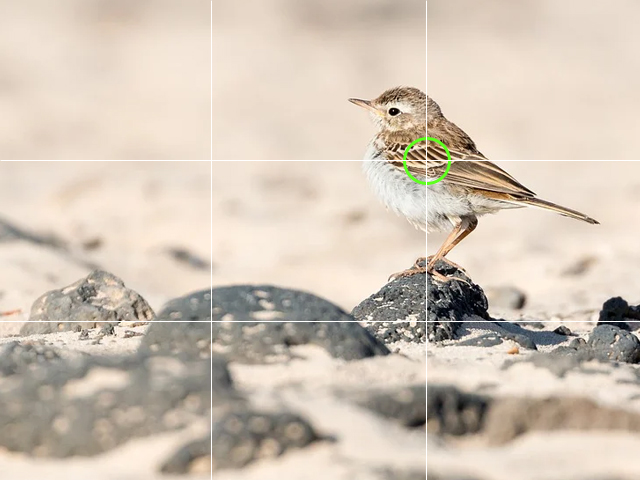1. Use the grid lines
You know when you're taking a picture and you want to make sure everything is aligned and looks good? Well, that's where grid lines come in handy. They're like a bunch of straight lines that show up on your camera's viewfinder, and they form a grid pattern that divide the image into nine equal parts.
The idea is to divide the shot into thirds, both horizontally and vertically. That way, you can use something called the "rule of thirds" to place your main subject or important parts of the picture along the lines or at the intersections.
It helps balance everything out and make the picture look better. Plus, you can use the grid to make sure your camera is level and the horizon is straight.

When taking a picture, one of the common mistakes people make is trying to place the main subject of the picture in the center of the shot.
Instead, it is recommended to use the "Rule of thirds", where the subject is placed along the grid lines or at one of the intersections. This is because our eyes are naturally drawn to one of these four points, rather than being centered in the shot.

So, by placing the subject along one of these points, it can create a more visually interesting and appealing composition. The grid lines serve as a guide, but it's important to not be too rigid in sticking to them and to consider the overall composition of the shot.
Have you heard of the "Rule of thirds"? Basically, instead of putting the main subject of the picture right in the middle, you place it along one of the lines or at one of the intersections that the grid lines create.

That subject can be anything - a person, a dog, an object, a group of objects, you name it. It's all about creating a balanced and visually appealing composition.
If you can't see grid lines in your camera screen check the camera settings. Some cameras have a built-in grid display feature that can be turned on or off. Check your camera manual to see if this is an option and how to activate it.
2. Image stability and quality
I always make sure to hold the camera steady and press the button gently or use a voice command to take a picture. But did you know there's more to it than just that? It's also important to check the camera's shooting settings to make sure you're getting the best quality possible.
And did you know that for some smartphones, using a 4:3 aspect ratio gives you the highest quality image? With other ratios, you might end up with a picture that's cut off. It's all about getting the best shot, you know?

There are other factors that can affect the stability and quality of your images, such as:
-
Shutter speed: A slower shutter speed can lead to camera shake and blur in your images. To minimize this, you should use a faster shutter speed, or use a tripod to keep the camera steady.
-
ISO: The ISO setting on your camera determines the sensitivity of the sensor to light. Using a high ISO can result in increased noise in your images, which can affect image quality.
-
Aperture: The aperture setting on your camera controls the amount of light that reaches the sensor. A wider aperture (lower f-number) can result in a shallower depth of field and a blurred background, which can make your subject stand out more.
-
Lens quality: The quality of the lens you use can also affect image quality. Investing in high-quality lenses can result in sharper, clearer images with less distortion and chromatic aberration.
-
Lighting: Good lighting is essential for capturing high-quality images. Shooting in low light can result in images that are grainy, blurry, or under-exposed.
3. Without shaded parts
You know how you want to make sure your pictures turn out looking their best, right? Well, one thing to keep in mind is that even lighting is key. If there are dark parts, it'll feel like parts of the picture are missing. That's why I try to avoid having any shadows in my shots.
And speaking of lighting, it's important not to compromise on that either. If you're indoors, you might open the shutter or turn on a bright lamp. And if you're outside, try to find an angle that gives you the most light from the sun. Don't forget to turn on HDR too.
And finally, I only use flash as a last resort. It's important that the whole picture is evenly lit, so make sure you're using flash carefully.

Look at that picture of the waterfall in Yellowstone that I took. Well, I wanted to make sure that the whole picture was well lit so people could see all the details, including the trees below the waterfall. To achieve that, I had to be mindful of the lighting. I made sure that there weren't any dark parts that would hide any of the beauty of the scene.
I probably found an angle that would give me the best light, maybe by positioning myself in a way that the sun would light up the whole scene. Or I might have turned on HDR, which helps to balance out the lighting in a picture and can bring out more details.
4. Focus on the subject of the image
Focusing on the subject of an image is important because it helps to draw the viewer's attention to the main point of interest in the picture. When the subject is in focus, it appears sharp and clear, while the background might be blurred, which further emphasizes the subject and helps it stand out.
Additionally, by focusing on the subject, you can control the composition of the image and guide the viewer's eye through the picture. This can help to create a more dynamic and visually interesting image that captures the viewer's attention and conveys a specific mood or message.
Overall, focusing on the subject is a key aspect of photography and can greatly improve the quality and impact of your images.

When you're taking a picture, the camera has to focus on the subject before it can take the shot. This process can take a little time, especially in low light or complex scenes. During this time, the camera might struggle to find the right focus and appear to be searching back and forth.
That's why it's important to be patient and wait for the camera to finish focusing before taking the shot. If you take the picture too soon, the subject might not be in focus and the image quality will be lower. So, just wait a moment and let the camera do its thing, and you'll get a better result.
Sometimes, taking a picture with just the subject in focus isn't possible, especially in challenging lighting conditions or when the subject is moving. In these cases, it's still important to try to get the subject within the focused area of the image, so it doesn't appear blurry.
This means that even if the background is blurry, the subject should still be sharp and clear enough to be recognizable. By having the subject within the focused area, you ensure that the main point of interest in the picture is still visible and legible, even if the rest of the image is less sharp. This way, you still capture a good image despite the challenging conditions.
5. Seize the moment
When taking a picture, it's all about capturing the moment. That one second that can make all the difference. Like this picture of the cat, a yawning cat is such a fleeting moment and if you miss it, you miss the magic. So, if you have the chance to snap that moment, do it! Don't hesitate, just go for it. A picture that captures the moment has so much more impact and evokes stronger emotions than a picture that just looks nice.

So you're at a gorgeous spot, right? Make sure to snap a pic while you're there. And if your family or friends are laughing, go ahead and try to capture their real smile. Don't worry too much about following all the photography tips, just keep snapping away. At the end, you can pick the best one. And if nothing seems to be working, remember you can always edit the picture later. The most important thing is to capture that moment!
Summary
Capturing the moment is key in photography. While it's important to follow rules and tips, like setting a subject and ensuring good focus and lighting, don't forget that the moment itself is what brings life to the picture. So, don't hesitate, seize that moment and make it your priority when taking a photo.



